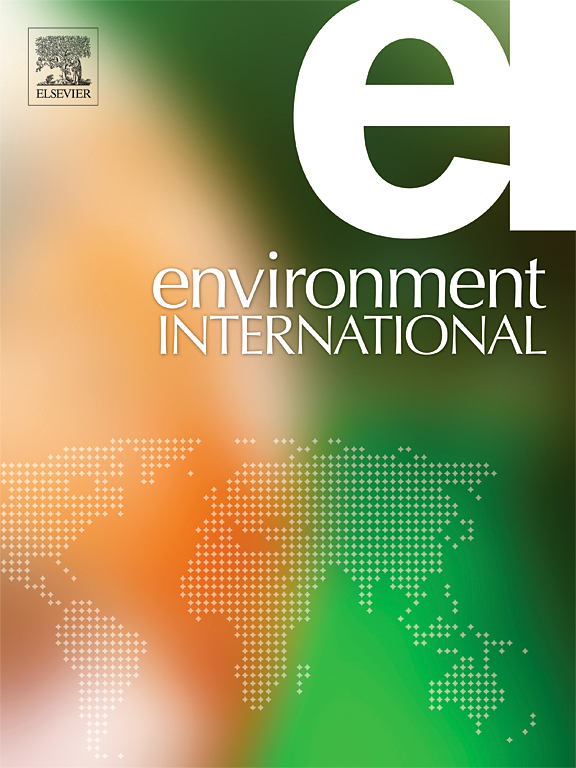PFAS in first-time mothers from Sweden: temporal trends and the impact from fish/seafood consumption and drinking water exposure
IF 9.7
1区 环境科学与生态学
Q1 ENVIRONMENTAL SCIENCES
引用次数: 0
Abstract
Per- and polyfluoroalkyl substance (PFAS)-contaminated drinking water has been a significant source of human exposure to PFAS in Uppsala, Sweden. Herein, we investigated temporal trends of PFAS in serum samples collected three weeks after delivery from first-time mothers in Uppsala (1996–2022; n = 869), to determine whether efforts to remediate drinking water contamination have reduced maternal PFAS exposure. In addition, the impact of fish/seafood consumption as an exposure source was evaluated. PFAS were analysed by ultra-high performance liquid chromatography-tandem mass spectrometry (UPLC-MS/MS) and temporal trends were evaluated using adjusted cubic spline models.
Linear (lin) and branched (br) perfluorooctane sulfonate (PFOS) and perfluoroctanoate (PFOA) showed declining temporal trends, likely due to international regulation and phase-out initiatives. Later initiatives to restrict use and emissions of perfluorononanoate (PFNA), perfluorodecanoate (PFDA) and perfluoroundecanoate (PFUnDA) likely explained the initial increased concentrations by 3–7% per year, up to 2007 or 2010, followed by decreasing trends, on average 2–3% per year. Drinking water contamination was likely responsible for the increase in serum br and lin perfluorohexanesulfonate (PFHxS) concentrations early in the study period, followed by a decline over the last decade associated with remediation of the drinking water contamination around 2012. However, even after remediation, drinking water appeared to contribute to perfluoropentanesulfonate (PFPeS) and PFHxS. Fish/seafood consumption was significantly associated with serum levels of lin PFOS, PFNA, PFDA, and PFUnDA.
Overall, PFAS exposure among first-time mothers in Uppsala has declined, resulting in a marked reduction in the proportion of mothers exceeding the serum reference value established by the European Food Safety Authority. Nevertheless, 54% of the mothers sampled from 2018 to 2022 still exceeded this level, showing that efforts to reduce PFAS exposure must continue for many years to come.
瑞典初为人母的PFAS:鱼类/海鲜消费和饮用水暴露的时间趋势和影响
在瑞典乌普萨拉,全氟和多氟烷基物质(PFAS)污染的饮用水是人类接触PFAS的一个重要来源。在此,我们研究了乌普萨拉(1996-2022;n = 869),以确定修复饮用水污染的努力是否减少了母体PFAS暴露。此外,还评估了鱼类/海鲜消费作为暴露源的影响。采用超高效液相色谱-串联质谱(UPLC-MS/MS)对PFAS进行分析,并采用调整三次样条模型评估时间趋势。线性(lin)和分支(br)全氟辛烷磺酸(PFOS)和全氟辛酸(PFOA)在时间上呈现下降趋势,可能是由于国际监管和逐步淘汰举措。后来采取的限制全氟壬酸盐(PFNA)、全氟癸酸盐(PFDA)和全氟癸酸盐(PFUnDA)使用和排放的举措,可能解释了直到2007年或2010年,其浓度最初以每年3-7%的速度增长,随后呈下降趋势,平均每年2-3%。饮用水污染可能是研究初期血清溴和全氟六磺酸盐(PFHxS)浓度升高的原因,随后在过去十年中,由于2012年前后对饮用水污染进行了补救,血清溴和全氟六磺酸盐浓度有所下降。然而,即使经过补救,饮用水似乎也会产生全氟戊烷磺酸盐和PFHxS。鱼类/海鲜消费与血清中PFOS、PFNA、PFDA和PFUnDA水平显著相关。总体而言,乌普萨拉首次生育的母亲接触PFAS的情况有所下降,导致超过欧洲食品安全局确定的血清参考值的母亲比例显著减少。然而,从2018年到2022年取样的母亲中有54%仍然超过了这一水平,这表明减少PFAS暴露的努力必须在未来许多年继续下去。
本文章由计算机程序翻译,如有差异,请以英文原文为准。
求助全文
约1分钟内获得全文
求助全文
来源期刊

Environment International
环境科学-环境科学
CiteScore
21.90
自引率
3.40%
发文量
734
审稿时长
2.8 months
期刊介绍:
Environmental Health publishes manuscripts focusing on critical aspects of environmental and occupational medicine, including studies in toxicology and epidemiology, to illuminate the human health implications of exposure to environmental hazards. The journal adopts an open-access model and practices open peer review.
It caters to scientists and practitioners across all environmental science domains, directly or indirectly impacting human health and well-being. With a commitment to enhancing the prevention of environmentally-related health risks, Environmental Health serves as a public health journal for the community and scientists engaged in matters of public health significance concerning the environment.
 求助内容:
求助内容: 应助结果提醒方式:
应助结果提醒方式:


